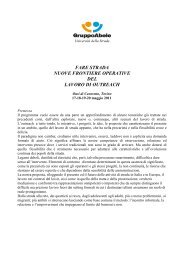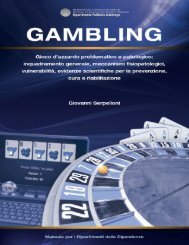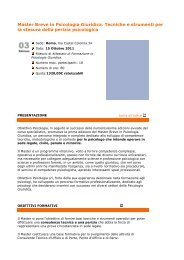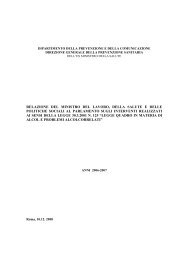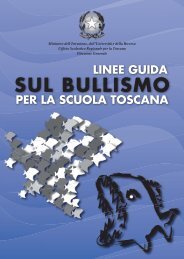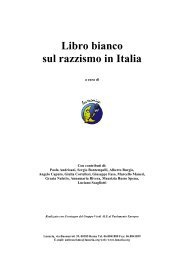Neuroscienze e dipendenze - Dipartimento per le politiche antidroga
Neuroscienze e dipendenze - Dipartimento per le politiche antidroga
Neuroscienze e dipendenze - Dipartimento per le politiche antidroga
You also want an ePaper? Increase the reach of your titles
YUMPU automatically turns print PDFs into web optimized ePapers that Google loves.
I VIEDOGIOCHI VIOLENTI POSSONO INDDURRE COMPORTAMENTI AGGRESSIVI NEI RAGAZZI … - 187<br />
BIBLIOGRAFIA<br />
1. Aderman, D.; Berkowitz, L. (1970). Observational set, empathy, and helping. Journal of Personality and Social Psychology. Vol.14, pp. 141-<br />
148.<br />
2. Amadei, Gherardo (1998). Lo psicoanalista e il mondo esterno: quali possibilità di ricerca scientifica In Imbasciati, A.; De Polo, R.; Sigurtà,<br />
R. (a cura di) Schermi vio<strong>le</strong>nti. Catarsi o contagio Borla: Roma.<br />
3. American Psychiatry Association (1978). Dizionario di psichiatria, Ed. New Compton, Città di Castello.<br />
4. Anderson CA, Bushman BJ. Effects of vio<strong>le</strong>nt video games on aggressive behavior, aggressive cognition, aggressive affect, physiological<br />
arousal, and prosocial behavior: a meta-analytic review of the scientific literature. Psychol Sci. 2001 Sep;12(5):353-9<br />
5. Antinucci, F. (1992). Piaget vive nei videogiochi. Psicologia Contemporanea. Marzo- Apri<strong>le</strong>, Vol 19 (110).<br />
6. Bandura A, Ross, D.; Ross, S. (1963). Vicarious reinforcement and imitative <strong>le</strong>arning. Journal of Abnormal and Social Psychology, Vol 67<br />
(6), pp. 601-607.<br />
7. Bandura A. (1965). Influence of models’ reinforcement contingencies on the acquisition of imitative responses. Journal of Personality<br />
and Social Psychology, 1, pp. 589-595.<br />
8. Bandura, A. (1971). Social <strong>le</strong>arning theory. New York: General Learning Press.<br />
9. Bandura, A. (1973). Aggression: a social <strong>le</strong>arning analysis. Eng<strong>le</strong>wood Cliffs, Prentice-Hall.<br />
10. Baron, R. A. (1977) Human Aggression. New York, P<strong>le</strong>num Press.<br />
11. Berkowitz, L.; Corwin, R.; Hieronimus, M. (1963). Film vio<strong>le</strong>nce and subsequent aggressive tendencies. Public Opinon Quarterly. Vol.27,<br />
pp. 217-229.<br />
12. Berkowitz, L.; Geen, R. (1967). Stimulus qualities of the target of aggression: a further study. Journal of Personality and Social Psychology,<br />
Vol.5, pp.364-368.<br />
13. Bushman, B.J.; Geen, R.G. (1990). Ro<strong>le</strong> of cognitive-emotional mediators and individual differences in the effects of media vio<strong>le</strong>nce on<br />
aggression. Journal of Personality and Social Psychology, Vol.58, pp.156-163.<br />
14. Bushman BJ, Anderson CA. Vio<strong>le</strong>nt Video Games and Hosti<strong>le</strong> Expectations: A Test of the General Aggression Model. PSPB, Vol. 28 No. 12,<br />
December 2002 1679-1686<br />
15. Buss, A.; Durkee, A. (1957). An inventory for assessing different kinds of hostility. Journal of Consulting Psychology. Vol.21, pp.343-348.<br />
16. Buss, A. H. (1961). The psychology of aggression. New York, Wi<strong>le</strong>y.<br />
17. Bricolo F, Genti<strong>le</strong> DA, Smelser RL, Serpelloni G. Use of the computer and Internet among Italian families: first national study. Cyberpsychol<br />
Behav. 2007 Dec;10(6):789-97.<br />
18. Bricolo F, Serpelloni G. Addiction e uso della tecnologia digita<strong>le</strong>: revisione preliminare della <strong>le</strong>tteratura. In: Serpelloni G, Gerra G (a cura<br />
di) Vulnerabilità all’addiction. pp. 161-171, 2002<br />
19. Caillois, R. (2000), I giochi e gli uomini, la maschera e la vertigine, Tascabili Bompiani, Milano<br />
20. Calvert, Sandra L.; Tan, Siu Lan (1996). Impact of virtual reality on young adults’ physiological arousal and aggressive thoughts: Interaction<br />
versus observation. In Patricia M. Greenfield, Rodney R. Cocking (Eds.), Interacting with video. Advances in applied developmental<br />
psychology, Vol. 11. pp. 67-81.<br />
21. Caprara, G.V. (1983), La misura dell’aggressività: contributo di ricerca <strong>per</strong> la costuzione e la validazione di due sca<strong>le</strong> <strong>per</strong> la misura dell’irritabilità<br />
e della suscettibilità emotiva. Giorna<strong>le</strong> Italiano di Psicologia, X (1), pp.107-127.<br />
22. Caprara, G.V.; Renzi, P.; Amolini, P.; D’Im<strong>per</strong>io, G.; Travaglia, P.; (1984). The eliciting cue value of aggressive slides reconsidered in a <strong>per</strong>sonological<br />
<strong>per</strong>spective: the Weapon effect and irritability. European Journal of Social Psychology, Vol.14, pp.312-322.<br />
23. Caprara, G.V.; Renzi, P.; D’Augello, D.; D’Im<strong>per</strong>io, G.; Rielli, I.; Travaglia, G. (1985a). Interprpolating physiscal exercise between instigation<br />
to aggress and aggression: the ro<strong>le</strong> of irritability. Aggressive Behavior, Vol.12, pp.83-91.<br />
24. Caprara, G.V.; Borgogni, L.; Cinanni, V.; Di Giandomenico, F.; Passerini, S. (1985b). Indicatori della condotta aggressiva. Giorna<strong>le</strong> Italiano<br />
di Psicologia, X (1), pp.107-127.<br />
25. Caprara, G.V.; Pastorelli, C. (1989). Toward a reorientation of research on aggression. European Journal of Personality. Vol.3 (2), pp.121-<br />
138.<br />
26. Carnagey NL, Craig A. Anderson CA, Bartholow BD. Media Vio<strong>le</strong>nce and Social Neuroscience New Questions and New Opportunities. Current<br />
Directions in Psychological Science, Volume 16, Number 4, August 2007, pp. 178-182(5)<br />
27. Carlà, F. (1994). Space Invaders. La vera storia dei videogames. Interaction libri: Bologna.<br />
28. Cattel, R.B.; Sheier, I.H. (1961). The meaning of measurement of neuroticism and anziety. The Roland Press Company, New York.<br />
29. Cerami, Vincenzo (1998). Vio<strong>le</strong>nza virtua<strong>le</strong> e crisi della presenza. In Imbasciati, A.; De Polo, R.; Sigurtà, R. (a cura di) Schermi vio<strong>le</strong>nti. Catarsi<br />
o contagio Borla: Roma.<br />
30. Chambers, John H.; Ascione, Frank R (1987). The effects of prosocial and aggressive videogames on children’s donating and helping. Journal<br />
of Genetic Psychology, Dec Vol 148 (4) pp. 499-505.<br />
31. Chand<strong>le</strong>r, Daniel (1994). Video games and young players. Media and Communication Studies, december.<br />
32. Clark, M.; Isen, A. (1982). Toward understanding the relationship between feeling states and social behavior. In Hastorf, A.; Isen, A. (Eds.)<br />
Cognitive Social Psychology. New York: Elsevier.<br />
33. Collins, W.A.; et.al. (1974). Observational <strong>le</strong>arning of motives and consequences for te<strong>le</strong>vision aggression: a developmental study. Child<br />
Development, 45.<br />
34. Collins, W.; Getz, S. (1976). Children’s social responses following mode<strong>le</strong>d reactions to provocation: prosocial effects of a TV drama. Journal<br />
of Personality. Vol.44, pp.488-500.<br />
35. Collins, A.; Loftus, E. (1975). A spreading-activation theory of semantic memory. Psychological Reviw, Vol.82, pp.407-428.<br />
36. Colombo, F. (1989). Ombre sintetiche. Liguori: Napoli.<br />
37. Colombo, F.; Cardini, D. (1996). I videogame tra gioco e comunicazione. In Di Spirito, F.; Orto<strong>le</strong>va, P.; Ottaviano, C. (a cura di), Lo strabismo<br />
te<strong>le</strong>matico: contraddizioni e tendenze della società dell’informazione. UTET libreria [Roma], Te<strong>le</strong>com Italia, pp. 221-278.<br />
38. Colombo, Furio (1985). Rif<strong>le</strong>ssioni sui videogames. Comunicazioni Sociali. ottobre-dicembre, n.4, pp. 12-18.<br />
39. Colwell, John; Grady, Clare; Rhaiti, Sarah (1995). Computer games, self-esteem and gratification of needs in ado<strong>le</strong>scents. Journal of Com-



